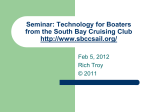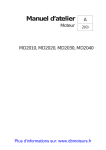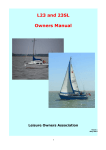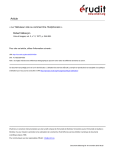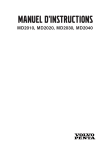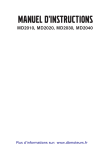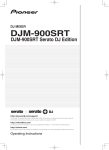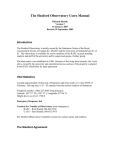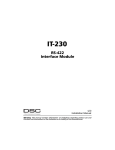Download Cobra MARINE MR HH300 EU Instruction manual
Transcript
Colonsay of Crinan Contents Boat Details Exterior Equipment Engine Starting the Engine Stopping the Engine Fuel Sails Winches Anchor Tender and Outboard Stern Ladder Navigation / wind instruments Interior Equipment Electrical System Domestic electrics Shore Power Galley and Gas Cabin Heater / hair dryer Fresh Water and Heads Location of Gear and Equipment Galley and saloon inventory Charts and Pilots List of Admiralty Charts Other Publications VHF procedures / Weather Forecasts International VHF Channels VHF Procedures Radio Distress Call Safety Information Safety Equipment Diagrams Safety Equipment Inspection List Grab Bag Contents Safety Briefing Checklist Safety Notes Calor Gas Safety Crinan Canal: Skipper’s Guide Guide to Visitors’ Swinging Moorings and Anchorages on the W. Coast. A separate (white) file contains equipment manuals 1 Vital Statistics LOA 9.68m / 31’ 9” LWL 8.08m / 26’6” Beam 3.3m / 10’10” Draft 1.68m / 5’6” Displacement 4634kg / 10, 218lbs (4.63 tonnes) Ballast 1475kg / 3,250lbs (1.47 tonnes) Height of masthead above waterline: approx. 13.5m / 44’ Hull Identification number: Yard Number: Small Commercial Vessel certificate number: Sail number: RYA Sail Training Stability Category SSR number: Call Sign: MMSI (Maritime Mobile Service Identity number) Ship Radio Licence Reference Last Full Survey (Murray, Cormack Associates): MPPGB006H495 E3015 Y02SV0090425 2194C 3 SSR111105 MV0I2 (Mike Victor Oscar India 2) 235 034 967 315087-K/177230/1 05.01.2004 Tankage Fresh water Fuel Sails Mainsail Genoa Storm jib 180 litres / 40 gallons 90 litres / 20 gallons 21m2 / 226 sq ft 27m2 / 290 sq ft Engine Volvo Penta MD2020B Three Cylinder diesel Anchors 25lb (11.4kg) CQR + 30m chain + 20m warp 7lb (3.2kg) Danforth + 10m chain + 30m warp Tripping line: buoy + 15m lightweight line (working load: 140lbs) Tender and Outboard Zodiac Inflatable 2hp Yamaha outboard Argyll Yachts (Tony Bennett) 01546 603500 / 07979 905445 Jonathan Sawday & Ruth Evans (owners) 0141 339 6952 / 07930 119602 2 EXTERIOR EQUIPMENT ENGINE The engine is an 18hp Volvo Penta 2020B, with a saildrive gearbox, which delivers power to a two-bladed folding propeller. Max. Cruising speed is 6knts @ 2,500rpm. THERE IS NOTHING TO BE GAINED BY EXCEEDING 2,500 RPM, SO PLEASE DON’T! Engine and gearbox oil dipsticks are accessed via the aft cabin. CHECK OIL LEVELS DAILY IN THE MORNING WHEN ENGINE IS COLD. DO NOT OVERFILL. Please avoid running the engine for long periods in neutral. The engine should preferably be run under load. Engine and gearbox use the same oil. One litre of spare oil is in the cockpit locker. Engine spares (filters, impeller, belt) are in the locker below the chart table. Tools are in the seat locker in the aft cabin. When sailing, and engine is off, engage reverse gear (this folds the prop). STARTING THE ENGINE Batteries to “ALL” on main switch at chart table. Gearbox in neutral (throttle lever vertical). Press power switch on engine control panel (cockpit). Panel lights illuminate. Check alarm is operating by depressing alarm button on panel. Hold the heat switch up (“glow”) for approx. 10 secs. Press start button. Once the engine is running, depress red button on throttle lever (this disengages the gear), and gently move lever forward until the charge / alternator light on control panel is extinguished. 8. Check cooling water is coming out of the exhaust (stern). 9. Once engine is warm, return throttle to neutral. 1. 2. 3. 4. 5. 6. 7. STOPPING THE ENGINE 1. Allow engine to “idle” for a few minutes, particularly after running at high revs. 2. Return throttle to neutral. Pull out strangler lever. 3. Turn off power at engine control panel. 4. Push back strangler lever. 5. Turn battery switch to either “1” or “2” on main switch panel at chart table. FUEL Fuel tank is located under the floor of the cockpit locker. Capacity is 20 gallons / 90 litres. Consumption is 2 litres per hour at cruising speed (6 Kts). Hence, range is approx. 45 hrs (= approx. 270 miles). Filler for fuel is located on the port quarter. Tighten filler cap after use. Spare 10 litres of fuel is in cockpit locker. 3 Fuel gauge is located on the main panel above chart table. It illuminates when power is switched on at engine panel. Fuel supply cut off valve is at forward end of cockpit locker. Fuel supply runs the cabin heater. If this is used a lot, adjust fuel consumption figures (above). Anti-bacterial agent for adding to fuel is in the cockpit locker. Follow instructions on label. SAILS Furling genoa is permanently rigged. Keep some tension on sheets when furling sail and in harbour. Spare forestay is tied off to the shrouds on the starboard side. If needed, the forestay attaches to a shackle in the bow. Storm jib is under central berth in forward cabin. Mainsail is stowed on boom. Two reefing lines are fitted; these (together with halyards) are led aft to cockpit. There are reefing points for a third reef on the mainsail. Outhaul on mainsail should not need to be adjusted. WINCHES Winches are stripped and serviced annually. However, should problems arise, a Lewmar manual can be found in the “White File” and a winch service kit (containing replacement pawl springs, collets, spindles etc.), together with grease can be found in the seat locker in the aft cabin. Light engineering oil is in the Chart table locker. Use grease sparingly. ANCHOR Main anchor is 25lb CQR, attached to 30m chain and 20m warp, which is in turn attached to anchor locker. Anchor is stowed in anchor locker when not in use. Anchor windlass is manually operated using the smaller winch handle. Anchor chain is marked: 10m 20m 30m Green Yellow Red Kedge anchor (7lb danforth) is stowed in cockpit locker with 10m chain and 30m warp. A tripping line ( + small orange buoy) is also stowed in the cockpit locker. Secure chain / warp to bow cleat; do not leave on the windlass. Please take care of the bow of the boat when retrieving the anchor. Under no circumstances should the boat be motored forward with the anchor still to be retrieved. The bow will be checked after each charter for damage. 4 ANCHOR LIGHT To conserve electricity, the 12W fluorescent light (in chart table locker) can be connected to the cigarette lighter socket above the chart table and activated by the VHF switch on the main switchboard. This can be hung from the boom, in lieu of the 20W masthead light. TENDER AND OUTBOARD Tender is a Zodiac inflatable. Roll out on foredeck, position seat, inflate (pump is in cockpit locker as are the oars) and lower over side. You can tow the tender in calm weather, having removed the outboard first. Outboard is a 2hp Yamaha 2 stroke, 1:100 oil: petrol mix. Spare fuel is in cockpit locker. To operate outboard: 1. 2. 3. 4. Turn on fuel, open breather on top of fuel tank. Turn choke knob and lift throttle approx. 1/3 to start position. Pull starter handle till engine starts. Once engine is running, turn choke switch back to off, set throttle to even tickover. 5. To go astern, rotate engine. 6. To stop, push stop button. STERN LADDER and CARE OF THE TILLER When accessing stern ladder from cockpit, please do not allow the step to “thump” onto the stern. This (as you can see) causes damage. The tiller has been recently (and expensively!) repaired. Steering the vessel with the tiller in the “up” position damages the tiller by rubbing it against the boarding step. This, in turn, causes rot to set in, and seriously weakens the structural integrity of the tiller. Please ensure the tiller is in the “down” position when steering, particularly when going astern. The tiller extension arm can be used to provide better visibility. AUTOHELM WIND AND CLOSE HAULED / VMG; TRIDATA AND REPEATER / GPS AND NAVDATA You will find manuals relating to these instruments in the “White File”. Various waypoints have been programmed into the GPS, but these should be used with caution. See note on GPS under “Charts” in this manual. The echo sounder is calibrated to show depth of water (rather than depth of water below the bottom of the keel), but this may have been altered. You are advised to check the calibration (a tape measure is in the tool box) against a known depth at the beginning of the charter. Draft is 1.68m / 5’ 6”. When the echo sounder is out of range of the seabed it will flash and then remain on last fixed depth. 5 INTERIOR EQUIPMENT ELECTRICAL SYSTEM Domestic electrics Two 100 AH batteries power the electrical system. These are located beneath the berth in the aft cabin. Engine needs to be run for 1 – 2 hours per day to keep these charged. It is always better to run the engine under load. Fridge should be turned off when engine is not running, or when not connected to shore power. When sailing, have batteries switched to “1” or “2”. 12v cigarette lighter (for charging portable VHF / Mobile phones, etc) is above the chart table, beneath the main switch panel. This is operational when VHF switch is activated at main panel. Shore Power Shore power lead (+ extension) is kept in cockpit locker, where the shore power plug is also located (aft end of locker on floor). Shore power operates a) battery charger (switch at forward bulkhead in cockpit locker) b) two sockets aft of cooker. Leave charger in on position. Engine may be started with shore power connected; cabin heater may also be run under shore power alone. GALLEY AND GAS Gas locker is located at forward end of cockpit locker. It contains two calor gas bottles. Gas should be switched off here at night. “Auf” = open, “Zu” = closed. Gas is also shut off at valve below cooker. Rings and oven have a thermocouple. Hold button in for a few seconds once gas is lit. The Gas alarm is located besides the stereo on the chart table. It is on when batteries are switched on. If alarm sounds: 1. 2. 3. 4. Extinguish all naked lights. NO SMOKING! Turn gas off at source. Open all hatches / ports. Ventilate boat. Pump bilge MANUALLY. (Bilge pump is in cockpit. Bilge pump handle in cockpit locker). FRIDGE (COOL BOX) The cool box is located next to the cooker. Activating switch is on the main switchboard above chart table, marked “Fridge”. Only run the fridge when the 6 engine is running and the batteries are charging, or when shore power is connected. HAIR DRYER A hair dryer which operates off the main sockets by the galley (and hence can only be used when connected to shore power) is stored in the locker beneath the chart table. CABIN HEATER The vents for the cabin heater are in the saloon beneath the chart table, and in the aft cabin. The heater is situated in the cockpit locker. Only start the heater with the engine running, or when shore power is connected. Once it has started, the engine may be turned off. To start the heater: Press rocker switch to right. Return rocker switch to left to turn heater off. It will take a few minutes to shut down, during which time the batteries should not be switched off. If the heater does not fire up immediately, wait a few minutes and try again. FRESH WATER AND HEADS Freshwater capacity is 40 gallons / 180 litres. Water gauge is activated when water pump is switched on at main panel. Spare 10 litres of water is in cockpit locker. Water filler is amidships on the port side. Tighten filler cap after use. Tanks are located beneath the saloon berths. Fill tanks slowly to prevent airlocks forming. The engine heats hot water. Water pump (main switch panel) pressurises hot and cold water to galley and to basin in heads. Shower nozzle in heads pulls out from basin. Shower discharges into bilge, so pump out bilge after using shower. Heads. The toilet is flushed using seawater. Providing you use of plenty of water and only a little paper at a time, there is no reason why the Heads should become blocked. Nothing else must go down toilet. Clearing blocked Heads involves a £50 surcharge. Operate Heads as follows: 1. Move pump switch to left and pump until there is about 5” of water in the pan. 2. On finishing ablutions, move pump switch to right and pump pan dry. 3. Move switch to left and give at least 15 pumps to clear the pipes. 4. Return switch to right and pump again until pan is dry. Leave Heads like this. 7 Where is the…? Ensign and staff Aft cabin seat locker Tool Box Wire cutters Winch service kit & grease Chart Table 2 hand-held flares Portable VHF + charging lead Emergency VHF antenna 3 winch handles Bearing compass, Plotter, Dividers Sliding Rule Rubbers, pencil sharpeners, pencils CD player and Radio Gas alarm Fire blanket (beneath table) Imray charts / Log book Cockpit Locker 1 canister offshore distress flares: 6 parachute flares 6 red hand flares 2 orange smoke signals Bilge pump handle Kedge anchor (7lb danforth, 10m chain, 30m warp) Bucket, Deck brush Mooring warps, spare lines Sail cover Throwing line 2 dingy oars Container for outboard fuel (1:100 oil Petrol mix) Grab Bag, containing: Sea anchor First aid kit Signalling mirror 2 red rocket flares 3 red hand flares Smoke signal Thermal blankets Solas table of signals Radar reflector Whistle Ball and triangle shapes 2 x 24m Shore-power cables 10 litres fresh water 10 litres diesel fuel Spare 10 l. water container Engine / gearbox oil Anti-bacterial agent (for fuel) 2 calor gas bottles Tiller extension Fuel / water funnels Fenders (x 5) Tripping line (15m) + buoy Cockpit 2 lifebelts + lights + drogues 1 Danbouy + drogue Outboard (Yamaha 2 hp 2-stroke) Chart Table Locker Engine spares Small fly screens (for ports) Sail ties Foghorn Spotlight, softwood plugs Boson’s chair, hair dryer WD40, Vaseline, light oil 12W fluorescent light Hair dryer Forward Cabin Bin (port) 6 Baltic lifejackets (manual) 2 Paramis lifejackets (manual) 8 harnesses 8 lifelines 1 “Quickfit Junior” child’s lifejacket and harness (in bag) (automatic). Forward Cabin Bin (centre) Storm jib. Large fly screens (for hatches) Saloon Shelves First Aid Kits Pilots, Maps, Western Almanac Fishing line Below saloon mattresses 3 folios admiralty charts Coach roof Zodiac inflatable Life raft Whisker pole & boat hook 8 Galley and Saloon Inventory 1 kettle 1 cafetière 1 rectangular Pyrex dish (in oven) Locker above cooker 6 side plates 6 dinner plates 6 soup/cereal bowls Cutlery in plastic box: 6 dinner knives 6 side knives 6 dinner forks 6 dessert forks 6 dessert spoons 6 soup spoons 6 tea spoons Matches Locker to right of cooker 8 melamine mugs 1 teapot 1 sugar canister 1 plastic container for teabags 3 sharp kitchen knives 2 bottle openers 1 gas lighter 1 soup ladle 1 spaghetti lifter 1 bundle of bamboo skewers 1 spatula 1 fish slice Under sink 1 set of essential kitchen and cleaning supplies (washing up liquid, Jcloths, Cif, pan scrubber, rubber gloves, etc.) 4 saucepans and 3 lids 1 frying pan 1 measuring jug 1 grater 1 large salad/soup bowl 1 medium salad/soup bowl 1 colander Under cooker Pyrex dish Baking tray Saloon 2 small cork pot stands 6 table mats 2 plastic cereal containers with lids 1 square plastic container with lid 1 fish-shaped plastic bowl 1 large plastic jug 2 circular plastic chopping boards Port Locker (saloon) 10 glass tumblers 1 pepper mill Galley Area 1 oven glove 1 metal kitchen roll holder Cutlery drawer next to sink 1 stainless steel serving spoon 4 wooden spoons 1 handle for oven grill pan 1 hand beater 1 set salad servers 1 pair kitchen scissors 2 tin openers 2 potato peelers 1 bread knife Aft Cabin (Locker) 1 peg bag with pegs Hanging lockers 14 plastic coat hangers Chart Table Various travel board games Pack of cards 9 Charts and Pilots Colonsay usually carries 77 admiralty charts (including duplicates of 2126 and 2798) for the W. Coast of Scotland, together with various other Imray charts, ordnance survey maps, pilot books, and the 2006 Western Almanac. These are all listed overleaf. Admiralty charts are divided into three folios: A, B, and C. The folios are organized by chart number. Folio A contains 33 charts for areas N. of Ardnamurchan Point; Folio B contains 27 charts for areas S. of Ardnamurchan Point; Folio C contains 17 charts for the Firth of Clyde and Approaches. It would help us if you could replace the charts in the correct folio after you have used them. Correct order would be even better! Charts are replaced when they wear out, usually with copies correct to latest Notices to Mariners. Hence charts for the more remote / less popular areas may be quite old. The Western Almanac should be consulted for latest information on lights, buoys, etc. Charts and pilot books are, of course, expensive. Please try not to take them into the cockpit, particularly in wet weather. If charts or pilot books do become wet with salt water, wipe them down with a damp cloth (fresh water) and dry them out flat (on top of the engine is a good place). Please, never put damp charts back into the folios, since this encourages mould. Waypoints, GPS, Chart Datum The boat’s GPS is programmed with various waypoints, but these have not been checked against charts. If you are bringing your own GPS with waypoints already programmed in, remember to check these against the relevant charts before setting off. Charts for much of the W. Coast of Scotland, west of the Mull of Kintyre, are referenced to the Ordnance Survey of Great Britain 1936 datum (OSGB 36), and not to WGS 84. Hence, if you are bringing your own GPS receiver on board, you may need to adjust the receiver’s datum to OSGB 36, or adjust WGS 84 derived positions before plotting them onto charts referenced to OSGB 36. Note, however, that two charts (2642, Sound of Harris; 2841, Loch Maddy to Loch Resort including the Sound of Harris) are referenced to WGS 84. Charts in the Firth of Clyde are a mixture of WGS 84 and OSGB 36. Caution is advised in plotting GPS derived positions onto these charts. 10 VHF Operation and Procedures / Weather Forecasts The VHF set is located above the Chart Table. A new (2006) VHF / DSC set has been installed (Cobra F55EU). The MMSI number allocated to Colonsay is 235 034 967. This number has been programmed into the set, and the set connected to the boat’s GPS. Providing the navigation instruments are switched on, the boat’s position is shown on the screen of the set. If you are unfamiliar with DSC, you are advised to read the instruction manual in the “white file” (pp. 59 – 63). But here is a short guide to using the set. Lamp brightness, contrast, alarms etc are adjusted by entering the “programme” menu (pressing and holding the “call / set” button). Care should be taken in entering the programme menus, since it has been found rather too easy to inadvertently broadcast an “All Ships” call with this kind of radio! Exit the menu by scrolling down to “exit” and pressing the “call / set” button. Basic operation of the VHF is similar to a non-DSC set. To operate: Ensure batteries are switched on. Switch on VHF at main switch board Rotate On / Off switch. Adjust volume. Rotate “squelch” knob until clear of static. To transmit: depress transmit button firmly on microphone. DSC Features To make a distress (Mayday) call press the “distress” button twice. Activating this feature will transmit a distress call, signal the boat’s identity and position (if you also have the navigation instruments switched on) to all listening stations, and switch the radio to dual watch on chs. 16 & 70. Obviously, it will not transmit the nature of the distress, number of persons on board, etc. To abort a distress call, see handbook, p. 51. The set is currently programmed to allow automatic response to any position request. Further DSC features (e.g. sending / receiving an “All ships” call; sending / receiving an individual call to a vessel with a known MMSI number; sending a position request, etc.) are described in the handbook. A Mayday call can also be sent manually, treating the set as if it were nonDSC enabled. A “Mayday card” for Colonsay has been prepared and is kept in the chart table drawer. You may want to fix this next to the radio whilst you are sailing. 11 Portable VHF A new (2006) hand-held VHF (Cobra MR HH300 EU) is supplied. Manual is in the “white file.” The set can be charged either via the cigarette lighter socket above the chart table, or via the plugs next to the cooker, when connected to shore power. The set is placed in the base-charging unit (marked VHF and stored in the chart table), and this is connected to the electricity supply, using the leads which are also stored in the chart table. Batteries are 6 X AA rechargeable alkaline batteries A guide to VHF channels / coastguard etc. on the W. Coast of Scotland can be found in the 2006 Western Almanac. Weather Forecasts Details of weather forecasts are to be found in the 2006 Western Almanac. In summary, weather forecasts are obtained from: Clyde CG and Stornoway CG who broadcast regular weather forecasts. Forecasts are initially announced on Ch. 16, which will indicate which channel will be used for the broadcast (usually 10, 24, 73, 84, 86, depending on where you are). Tune in to the channel that seems clearest. Broadcast times are as follows: For Clyde Forecasts: (Mull of Galloway to Mull of Kintyre, and Mull of Kintyre to Ardnamurchan Point) Inshore waters forecast: 0020, 0420, 0820, 1220, 1620, 2020. Shipping Forecast (sea areas Bailey, Hebrides, Rockall, Malin): 0820, 2020. For Stornoway Forecasts: (Ardnamurchan Point to Cape Wrath and Outer Hebrides) Inshore waters forecast: 0110, 0510, 0910, 1310, 1710, 2110. Shipping Forecast (sea areas Fair I, Faeroes, Bailey, Malin, Hebrides, Rockall): 0910, 2110. NB all times UTC: add one hour for summer time. . 12 SAFETY EQUIPMENT Seacock locations are shown on the diagram overleaf. Flares are located in the cockpit locker. The pack should contain: 6 parachute flares, 6 red hand flares, and 2 buoyant smoke signals. There are also flares above the chart table and in the grab bag. Lifejackets (manually inflated), harnesses and personal safety lines are in the forward cabin (port bin under berth). Do not attach safety lines to guard rails. Use jackstays and standing rigging. A child’s lifejacket (Quickfit Junior self-inflating with harness) is also in the bin. Dan Buoy and Life belts (with beacons and drogues) are on pushpit. Throwing line is in cockpit locker Softwood plugs are in the chart table locker and in the cockpit locker. Spare forestay is tied off to the starboard shrouds. Manual bilge pump is on port side of cockpit. Bilge pump handle is in cockpit locker. Wire Cutters (which will cut the standing rigging) are in the toolbox in the seat locker in the aft cabin. Emergency VHF antenna is above chart table. Mayday card is in the chart table drawer. Fire extinguishers (x 5)are located according to the diagram overleaf. A fire blanket is under the chart table. Spotlight is in the chart table locker. Torches are in the aft and forward cabins and above chart table. Grab bag is in cockpit locker, and contains: Sea anchor; First aid kit; Signalling mirror; 2 red rocket flares; 3 red hand flares; Smoke signal; Thermal blankets; Solas table of signals; Radar reflector; Whistle. Foghorn (and spare canister) is in the chart table locker. Portable VHF is in the chart table drawer. First Aid Kits are in the saloon (stbd. side). Please use the kit in the plastic container for day-to-day issues. Breaking into the foil MCA kit will mean that it has to be replaced at a cost of £55 to the Charterer. Life raft is self-launching as a last resort, but for this to happen the boat will have sunk. Only launch liferaft in extreme emergency (ie on fire or sinking). You are supposed to step up into the life raft! 2 litres of fresh water per crewmember should also be transported into the life raft. 13













